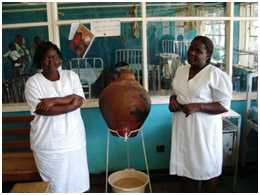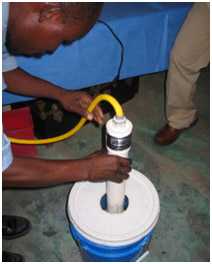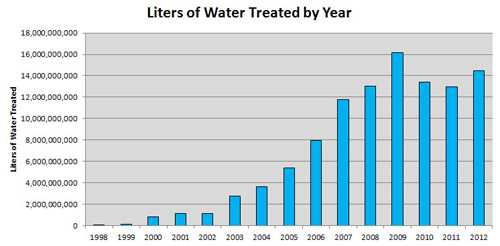Chlorination

Woman in Delhi using the SWS (P. Virot, WHO)
Chlorination [PDF – 2 pages]
The Safe Water System (SWS) was developed in the 1990’s in response to epidemic cholera in South America by the Centers for Disease Control and Prevention (CDC) and the Pan American Health Organization (PAHO). The treatment method for the SWS is point-of-use chlorination by consumers with a locally-manufactured dilute sodium hypochlorite (chlorine bleach) solution. The SWS also incorporates emphasis on safe storage of treated water and behavior change communications to improve water and food handling, sanitation, and hygiene practices in the home and in the community. To use the chlorination method, families add one full bottle cap of the sodium hypochlorite solution to clear water (or 2 caps to turbid water) in a standard sized container, agitate, and wait 30 minutes before drinking.
Lab Effectiveness, Field Effectiveness, and Health Impact
At concentrations that are used for household water treatment programs, the hypochlorite solution is effective at inactivating most bacteria and viruses that cause diarrheal disease. However, it is not effective at inactivating some protozoa, such as Cryptosporidium. Numerous studies have shown complete removal of bacterial pathogens in SWS treated water in developing countries. In seven randomized, controlled trials, the SWS has resulted in reductions in diarrheal disease incidence in users ranging from 22-84%. These studies have been conducted in rural and urban areas, and include adults and children that are poor, living with HIV, or using highly turbid water.
Benefits, Drawbacks, and Appropriateness

Nurses using the SWS in a hospital ward (A. Parker, CDC)
The benefits of chlorination are:
- Proven reduction of most bacteria and viruses in water
- Residual protection against recontamination
- Ease-of-use and acceptability
- Proven reduction of diarrheal disease incidence
- Scalability and low cost
The drawbacks of chlorination are:
- Relatively low protection against protozoa
- Lower disinfection effectiveness in turbid waters
- Potential taste and odor objections
- Must ensure quality control of solution
- Potential long-term effects of chlorination by-products
The SWS and chlorination are most appropriate in areas with a consistent supply chain for hypochlorite solution with relatively lower turbidity water, and in urban, rural, and emergency situations where educational messages can reach users to encourage correct and consistent use of the hypochlorite solution.
Local manufacturing of sodium hypochlorite solution in Haiti (Lantagne, CDC)
Implementation Examples

Local manufacturing of sodium hypochlorite solution in Haiti (Lantagne, CDC)
The Safe Water System has been implemented in over 35 countries.
Social marketing organizations, such as Population Services International (PSI), sell hypochlorite solution in over 20 countries. Since 1998 over 125 million bottles of hypochlorite solution, a volume of product sufficient to treat approximately 118.7 billion liters of household drinking water, were sold (as of 2013).
Local organizations use the socially marketed hypochlorite solution in their own programming to provide safe drinking water [PDF – 1 page]. For example, in Western Kenya nurses [PDF – 1 page] are trained to use SWS water in hospitals and teach patients with diarrhea to use the PSI SWS product WaterGuard™. In Uganda, people living with HIV [PDF – 2 pages] are given WaterGuard™ to prevent opportunistic diarrheal diseases. In Kenya, schoolchildren [1 page] are taught how and why to use the SWS and safe water clubs treat drinking water for all students. Also in Kenya, HIV self-help groups [PDF – 2 pages] sell SWS solution and storage containers as an income generating activity.
Faith-based groups, such as the Jolivert Safe Water for Families program [PDF – 1 page], make and bottle their own hypochlorite solution in rural areas. Local community health workers teach community members how to use the solution, make and distribute the solution, and follow-up with families to educate them on healthy water and sanitation practices.
Government ministries, such as the Ministry of Health in Guyana, work with local private companies to develop and market hypochlorite solution for emergency response. The SWS has also been widely used to respond to emergencies. SWS hypochlorite solution has been widely used to respond to emergencies from the 2004 tsunami in Indonesia to flooding and cholera epidemics in Africa and Haiti.
Economics and Scalability
A bottle of hypochlorite solution that treats 1,000 liters of water costs about 10 US cents using refillable bottles and 11-50 US cents using disposable bottles, for a cost of 0.01-0.05 cents per liter treated. Education and community motivation add to program costs. SWS programs can achieve full cost recovery (charging the user the full cost of product, marketing, distribution, and education), partial cost recovery (charging the user only for the product, and subsidizing program costs with donor funds), or can be fully subsidized such as in emergency situations.
In the PSI/Zambia project, the average cost per bottle (treating 1,000 liters) of production, marketing, and distribution at project initiation in 1999 was $1.88. This decreased by 82% to 0.033 US cents per liter treated in 2003, when 1.7 million bottles were sold, showing that significant cost efficiencies can be gained as programs grow to scale.
Population Services International, 1998 – 2013 Sales of SWS bottles converted to liters of treated water

Additional Resources
For more information about chlorination for developing countries, visit:
- Page last reviewed: April 23, 2014
- Page last updated: April 23, 2014
- Content Source:


 ShareCompartir
ShareCompartir